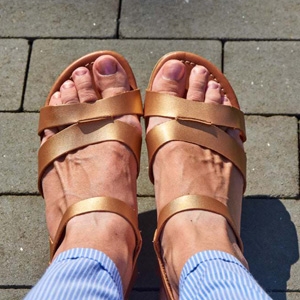It’s a phenomenon that many of us are familiar with: you’re pulling on your flip flops while enjoying a day of relaxation in the summer sun, and you have to struggle to get them on; it seems like your feet are bigger than usual. Is it your imagination? No, it isn’t – it is estimated that as many as half of all Americans have experienced this problem, and there are very specific biological reasons for why it happens.
When you are in a hot environment and your body becomes overheated, your blood vessels dilate in an effort to try to cool you off. This puts more strain on your circulatory system, however, as it has to work harder to transport blood back to your heart. This reduces your body’s ability to deal with the usual force of gravity, and your fluids are pulled down into the vessels in your ankles and feet, where they collect and then seep into the surrounding tissue. This causes your lower extremities to swell. Research has shown that heat edema can lead to swelling for periods of several days.
While this condition is not harmful, in some cases it can produce pain and irritation, and the affected skin might appear unsightly – puffy, shiny, and red. The swelling will recede when one returns to an environment that has a normal temperature, but it can be quite unpleasant while it is ongoing. If the swelling doesn’t go away within a few days, one should consult a physician in case there are other underlying health issues causing it (diabetes is one condition that can present with swelling in the feet).
Other Factors That Exacerbate Foot Swelling
While foot swelling – otherwise known as heat edema – is the body’s natural biological response to being in a hot environment, there are preventable factors that can intensify the problem. One is an excess of salt in one’s diet, which can lead to an imbalance in the body’s natural salt-to-water ratio: the body will retain water in an effort to compensate.
Sitting or standing for extended periods of time can also contribute to this problem. Moving the extremities helps the circulatory system to pump blood upwards; remaining sedentary makes it more difficult for the body to fight the force of gravity.
Other factors which can worsen heat edema include pregnancy, as pregnant women have a natural increase in body weight, which taxes the circulatory system more than usual, and introduces an excess of bodily fluids into the mother’s system. Swelling in the lower extremities is commonplace in any pregnant woman, and heat only increases the chances of this happening. Increasing age is another; our circulation weakens as time goes on, which in turn increases the chances of fluid pooling.
How to Reduce and Treat Heat Edema
While staying out of excessively hot temperatures is the best way to prevent heat edema, this obviously isn’t always possible. Drinking plenty of fluids (8-10 glasses of pure water per day) and maintaining a normal sodium intake are simple ways to try to avoid the condition. One should also be sure to avoid remaining stationary for too long and to get regular exercise, even if it’s just walking, especially during the cooler periods of the day; swimming is an especially good remedy. Also be sure to wear loose-fitting footwear and clothing.
But if heat edema happens despite these precautions, there are ways to deal with it. One is to keep your feet elevated, which aids your heart’s ability to pump fluids out of your feet and lower legs. This should be done several times per day for at least half an hour. When sleeping, you should keep a pillow under your feet to aid the process as well. Certain foods also serve as diuretics and help the circulation by getting rid of excess fluids through urination. These include asparagus, beetroot, green beans, leafy greens, lemons, onions, pineapple, pumpkin, and green beans.
Another treatment is to simply getting out of the heat, such as by avoiding direct sunlight, using fans, or going to an air-conditioned area. There are also cooling foot sprays that can help to relieve the strain. Don’t use excessively hot water when washing, either.
Massaging your feet and ankles can also bring relief, especially while using essential oils. Magnesium – taken in doses of 200 milligrams twice per day – can likewise help a great deal. While magnesium tablets are available, it can also be ingested naturally in certain foods, including avocados, bananas, dark chocolate, fish, kale, nuts, seeds, and spinach.
Lastly, horse chestnut extracts in gels, such as Venagel, can both provide relief and promote the reduction of heat edema once it has occurred, facilitating healing. A small amount of such gels should be massaged into the affected skin 2-3 times per day in an upwards motion, which promotes circulation.
Best Footwear for Swollen Feet
When all else fails, however, there are several types of footwear that have been designed to accommodate changes in the feet when swelling is experienced. Clarks Breeze Sea Flip Flop is one that has been evaluated by consumers as being especially suitable for dealing with heat edema. Others that have been rated highly include Cole Haan Zerogrand Stitchlite, Crocs Classic Clog, and Skechers GOwalk 5.
While heat edema is an unfortunate risk during hot weather, it is something that can be easily treated without seeking professional help.

